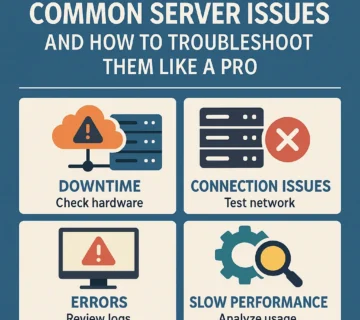The Role of Server Support in Ensuring Business Continuity

In today’s hyper-connected digital economy, business continuity has evolved from a luxury to an absolute necessity. Organizations across all sectors rely heavily on their IT infrastructure to deliver services, process transactions, communicate with customers, and maintain competitive advantages. At the heart of this infrastructure lies the often-underappreciated hero of modern business operations: server support. Understanding how robust server support contributes to business continuity is essential for any organization seeking to thrive in an increasingly digital landscape.
Understanding Business Continuity in the Digital Age
Business continuity refers to an organization’s ability to maintain essential functions during and after a disaster or disruption. While traditional business continuity planning once focused primarily on physical disasters like fires or floods, today’s threats are far more diverse. Cyberattacks, hardware failures, software vulnerabilities, human errors, and even minor configuration mistakes can bring operations to a grinding halt. The financial implications are staggering, with research indicating that downtime can cost businesses anywhere from thousands to millions of dollars per hour, depending on the organization’s size and industry. Beyond immediate financial losses, extended outages damage customer trust, tarnish brand reputation, and can result in regulatory penalties for industries with strict compliance requirements.
Server support serves as the foundation upon which effective business continuity strategies are built. Without properly maintained, monitored, and secured servers, even the most comprehensive disaster recovery plans become theoretical exercises rather than practical safeguards. Servers are the workhorses that store critical data, host essential applications, facilitate communications, and enable the digital transactions that keep modern businesses running. When server infrastructure falters, the cascading effects ripple throughout the entire organization, affecting everything from customer-facing services to internal operations and strategic decision-making processes.
Proactive Monitoring and Preventive Maintenance
One of the most critical aspects of server support is proactive monitoring, which identifies potential issues before they escalate into business-disrupting crises. Modern server support teams utilize sophisticated monitoring tools that track hundreds of metrics in real-time, including CPU utilization, memory consumption, disk space availability, network throughput, application performance, and security threats. These systems employ artificial intelligence and machine learning algorithms to establish baseline performance patterns and detect anomalies that might indicate emerging problems. When thresholds are exceeded or unusual patterns emerge, automated alerts notify support teams immediately, enabling rapid response before users experience service degradation or outages.
Preventive maintenance complements monitoring efforts by addressing known vulnerabilities and optimizing system performance on regular schedules. This includes applying security patches, updating firmware, replacing aging hardware components, optimizing database performance, cleaning up unnecessary files, and testing backup systems. Organizations that invest in comprehensive preventive maintenance programs experience significantly fewer unexpected outages and extend the operational lifespan of their hardware investments. The contrast between reactive and proactive approaches is stark: reactive organizations constantly fight fires and struggle with repeated crises, while proactive organizations maintain stable, reliable operations that support business objectives rather than hindering them.
Rapid Incident Response and Resolution
Despite the best preventive measures, incidents will inevitably occur. Hardware components fail, software bugs emerge, configurations drift from optimal states, and external threats probe for vulnerabilities. When problems arise, the speed and effectiveness of incident response directly determines the impact on business continuity. Professional server support teams follow established incident response protocols that prioritize rapid assessment, clear communication, systematic troubleshooting, and efficient resolution. These protocols ensure that critical issues receive immediate attention while less urgent matters are queued appropriately, preventing support teams from becoming overwhelmed during crisis situations.
Effective incident response requires both technical expertise and organizational preparedness. Support teams must maintain comprehensive documentation of server configurations, network topologies, application dependencies, and troubleshooting procedures. When incidents occur, this documentation enables faster diagnosis by providing immediate access to relevant information rather than requiring time-consuming investigation. Additionally, support teams conduct regular incident simulations and tabletop exercises that test response procedures, identify gaps in preparedness, and build team confidence in handling various scenarios. Organizations with mature incident response capabilities often resolve problems before customers even notice disruptions, maintaining the seamless experience that modern users expect.
Data Protection and Disaster Recovery
Data represents one of the most valuable assets for modern organizations, containing everything from customer information and financial records to intellectual property and operational insights. Server support plays an indispensable role in protecting this data through comprehensive backup strategies, secure storage practices, and tested recovery procedures. Effective backup strategies follow the 3-2-1 rule: maintaining at least three copies of data, stored on two different media types, with one copy maintained offsite or in the cloud. Server support teams configure automated backup systems, monitor backup completion and integrity, and regularly test restoration procedures to ensure that backups actually work when needed.
Disaster recovery planning extends beyond simple backups to encompass entire systems and applications. Server support teams work with stakeholders to identify critical systems, establish recovery time objectives (RTOs) and recovery point objectives (RPOs), document recovery procedures, and implement technologies that enable rapid restoration. Modern disaster recovery strategies often incorporate high-availability configurations, failover clustering, virtualization technologies, and cloud-based disaster recovery services that enable organizations to recover from catastrophic failures in minutes rather than days. Regular disaster recovery testing validates these capabilities and identifies weaknesses before real disasters strike, providing confidence that business operations can continue even in worst-case scenarios.
Security and Compliance Management
In an era of escalating cyber threats and increasingly stringent regulatory requirements, server security has become inseparable from business continuity. Server support teams implement multi-layered security approaches that protect infrastructure from external attacks, internal threats, and accidental exposures. This includes configuring firewalls, implementing intrusion detection and prevention systems, managing access controls, encrypting sensitive data, hardening server configurations, and maintaining security patches. These measures create defense-in-depth architectures that prevent single points of failure from compromising entire systems.
Compliance management represents another critical dimension of server support’s contribution to business continuity. Organizations in regulated industries must demonstrate adherence to standards like HIPAA, PCI DSS, GDPR, SOX, and numerous other frameworks that govern data handling, privacy protection, and operational controls. Server support teams ensure that infrastructure configurations meet compliance requirements, maintain audit trails, generate necessary reports, and facilitate regulatory audits. Non-compliance can result in severe penalties, operational restrictions, and reputational damage that threatens business viability, making this aspect of server support essential rather than optional.
Scalability and Performance Optimization
Business continuity isn’t solely about preventing disasters; it also encompasses the ability to adapt to changing business needs and maintain performance under varying conditions. Server support enables scalability by monitoring resource utilization trends, identifying bottlenecks before they impact users, and implementing capacity expansions proactively. Whether handling seasonal traffic spikes, supporting new product launches, accommodating business growth, or integrating acquired companies, server support ensures that infrastructure capabilities align with business requirements.
Performance optimization goes hand-in-hand with scalability, ensuring that existing resources deliver maximum value. Server support teams analyze performance metrics, identify inefficiencies, tune configurations, optimize databases, implement caching strategies, and recommend architectural improvements that enhance responsiveness and throughput. Organizations with well-optimized infrastructure achieve better user experiences, support more concurrent users with existing hardware, reduce operational costs, and maintain competitive advantages in markets where speed and reliability differentiate winners from losers.
The Strategic Value of Professional Server Support
Organizations face a critical decision regarding server support: building internal capabilities, outsourcing to managed service providers, or adopting hybrid approaches. Each model offers distinct advantages and trade-offs that must align with organizational capabilities, budget constraints, and strategic priorities. Internal teams provide deep organizational knowledge and immediate availability but require significant investments in hiring, training, and retaining specialized talent. Managed service providers offer access to broader expertise, 24/7 coverage, and predictable costs but may lack organization-specific knowledge. Hybrid approaches attempt to balance these factors, maintaining internal teams for strategic functions while leveraging external support for specialized skills or extended coverage.
Regardless of the chosen model, investing in professional server support delivers measurable returns through reduced downtime, improved security, enhanced performance, better resource utilization, and ultimately, stronger business continuity. Organizations that view server support as a strategic enabler rather than a cost center position themselves to capitalize on digital opportunities, weather unexpected challenges, and build resilient operations that support long-term success. As businesses become increasingly dependent on digital infrastructure, the role of server support in ensuring business continuity will only grow more critical, making it an investment that pays dividends across every aspect of organizational performance.
Conclusion
Server support represents far more than technical maintenance; it embodies the operational foundation that enables modern businesses to function reliably, securely, and efficiently. Through proactive monitoring, rapid incident response, comprehensive data protection, robust security practices, and strategic optimization, server support teams ensure that organizations can maintain operations through challenges, adapt to changing requirements, and capitalize on emerging opportunities. As digital transformation accelerates and business dependence on technology deepens, the strategic importance of server support will continue to grow, making it an indispensable component of any serious business continuity strategy. Organizations that recognize this reality and invest appropriately in server support capabilities position themselves not just to survive disruptions, but to thrive in an increasingly complex and competitive digital landscape.







No comment